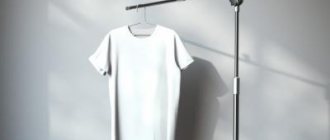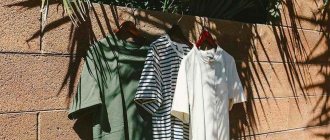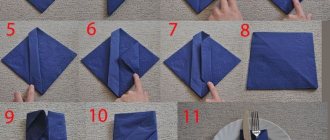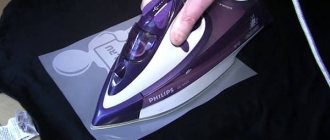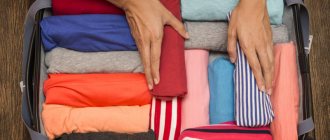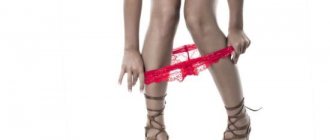Neatly and beautifully folded things are not only a paradise for perfectionists and a pleasing picture to the eye, but also a significant saving of time and free space in the closet (which, you see, is important). How convenient it is when you don’t have to waste precious minutes searching for your favorite T-shirt and then handling the iron. However, it is easy to say, but is it so easy to do? How to quickly and compactly fold a T-shirt so that it doesn’t get wrinkled in the closet? In this article we have prepared for you a photo and video overview of interesting and accessible methods that everyone can master.
If you immediately carefully fold a T-shirt, it will not wrinkle, will take up less space in the closet and will save time on ironing
You can quickly fold a T-shirt in several ways, you just need to practice a little, get used to it and choose the option that suits you.
Do not fold items immediately after ironing - creases will remain on the fabric. Hang the T-shirt on a hanger and let it cool slightly.
Popular folding methods
You need to fold the T-shirt so as not to wrinkle it. The most popular method is considered the classic one. To avoid creases, folding should not be done immediately after ironing; you need to wait a little.
Classical
There are two classic options for how to fold a T-shirt. They are conventionally called 1/3 (Italian) and 2/3. In the first case, the sleeve and 1/3 of the T-shirt are turned to the middle, in the second, the bottom of the product is folded by 10-15 cm. The choice of proportions depends on the size of the item. It is more convenient to fold large and wide men's T-shirts using the 2/3 technique, women's and children's - using the 1/3 technique.
| Peculiarities | The most common method |
| Advantages | Convenient for T-shirts |
| Flaws | This pattern takes practice. |
| How to do it step by step | Place on a flat surface, fold the right and left edges over the back in turn. Pull the bottom towards the collar, fold the product in half |
| If the T-shirt has long sleeves | They are bent parallel to the sides |
The folding algorithm on the surface and in weight will be approximately the same. In the second case, you should turn the front of the T-shirt (pattern) towards you and keep it strictly vertical. If wrinkles appear, they need to be straightened out.
1/3
2/3
Three point method
The method has other names: Chinese, fast. It is also often called this: in 2 seconds, in one movement. It's quite difficult to master.
| Specifics | It only takes 3-5 seconds to fold T-shirts neatly |
| pros | The product looks attractive when folded |
| Minuses | Complex algorithm of actions |
| Performance | To fold, you need to find the shoulder seam, from its middle to the line separating the top and bottom. Grasp these two points with your hands. With your right hand, fold the T-shirt downwards, leave your left without moving. |
| If the shirt is long sleeved | Not suitable for this type |
After finishing the work, you need to raise your hands and shake the product slightly. Then all the folds will straighten out. Now you can put the item in the chest of drawers. To master this method, it is better to use video instructions.
Using a board
To correctly fold the product using this method, you will need a special device. You can purchase it or make it yourself at home. This board is often used in clothing departments.
| Peculiarities | Availability of auxiliary equipment makes work easier |
| Advantages | A folded T-shirt always comes out flat |
| Flaws | Board required |
| How to do it step by step | Place the product face down and place a board on top. Fold the sides towards the center. Tuck the bottom |
| If the sleeves are long | They should be parallel to the edges |
It is convenient to store the board in a wardrobe. It is hung on the outerwear bar by the attached hangers. The device does not take up much space.
Tourist
This method is based on rolling the product into a roll. If everything is done correctly, the roller will be as tight and dense as possible. Before you start folding, you should make sure that the edges are clearly opposite each other. The resulting package should be placed edgewise in the suitcase, pressed against the corner, then it will not take up much space.
| Peculiarities | Good for packing luggage while preparing for travel |
| Advantages | The product does not wrinkle and does not require ironing after folding. |
| Flaws | It's difficult to get a perfectly straight roll |
| How to do it step by step | Place the product back up, fold the edges. You will get a rectangle that needs to be folded all the way |
| The nuances of folding long-sleeve T-shirts | Not suitable for this type of clothing |
The method is suitable for getting ready for a business trip or a hike. It is especially good to use when there is little space in your suitcase. A bag of any size will easily fit several neat scrolls. Every traveler should know how to roll a T-shirt.
Japanese
This method got its name from the Japanese woman Mon Kari, the girl who invented it. It is the most compact of all. The inventor worked as a cleaner for many years before she came up with her own method of storing things. Today it is popular all over the world. Thanks to a special technique for folding clothes, you can fit many more wardrobe items into your closet.
| Peculiarities | You can store your T-shirt upright |
| Advantages | Quick, the T-shirt can be easily found in the closet |
| Flaws | Requires practice, folding things neatly without practice is difficult |
| How to do it step by step | Fold 1/3. The sleeve will be on top. Place the second end of the product on the first overlap. Fold the resulting rectangle in half |
| What to do if the sleeves are long | They need to be tucked so they don't wrinkle. |
Children's
This is the simplest method. It is also sometimes called homemade. The product is folded in half, then folded lengthwise and crosswise.
| Specifics | Conveniently store clothes on dresser shelves |
| pros | Even a child can handle it |
| Minuses | There may be folds and unevenness, then you will have to iron |
| Performance | Place the T-shirt with the wrong side facing you, smooth it out, and point the sleeves towards the middle. Fold the rectangle vertically, then horizontally |
| What to do if the sleeves are long | They need to be smoothed carefully |
It is with this method that you can begin teaching your child to be neat. A 5-year-old child will easily remember all stages of work. He will be happy to apply the acquired skills at home and in kindergarten and tell his friends how to pack a T-shirt correctly.
Marie Kondo's method
Another method worthy of special attention was invented by the Japanese writer, author of many books on cleaning and housekeeping, Marie Kondo. She advises rolling up T-shirts, T-shirts and other things like a book. This makes it convenient to store them.
T-shirt folded like a book using Marie Kondo's method: YouTube/Ebury Reads
Did you like the idea? Then let's move on to its implementation:
- Place the washed and ironed T-shirt on a flat surface. If the item has a pattern, then fold the T-shirt with the print facing out.
- Visually divide the product into two parts.
- Fold the left side to the middle. Fold the sleeve over the already folded part.
- Do the same with the right side of the T-shirt.
- The result should be an even, elongated rectangle. It needs to be folded: bend the bottom part (by 10 cm) and tuck it to the middle. Do the same with the top of the T-shirt.
- It turns out to be a book made of fabric that can be easily placed vertically.
Marie Kondo recommends storing compactly folded T-shirts in drawers. The things you need are easy to find, they practically do not wrinkle and look aesthetically pleasing.
Nuances depending on the type of T-shirt
Each product has its own individual approach. It depends on the style and decor options. It is necessary to use different folding methods for the following product categories:
- T-shirts with prints;
- polo shirts;
- sleeveless jackets (or wrestling shorts);
- clothes with three-quarter sleeves.
You need to fold clothes so that they do not wrinkle and the fabric and decor do not become deformed when stored in a bag or closet. Women's T-shirts decorated with sequin embroidery require special care when handling. These items can easily fall off while packing the T-shirt.
With print
To fold a printed T-shirt correctly, place it on a hard surface with the wrong side facing you. To avoid the formation of microcracks in the drawing, it should never be bent. The sleeves are rolled over the back. If the image occupies the entire front surface, it is better to use the tourist method. Classic and children's patterns are also suitable.
If the product is decorated with an applique that is held on by glue, it must be rolled up in such a way as not to affect the design. Low quality pictures quickly come away from the fabric on folds and creases.
Polo
Before folding the polo, you need to check that there are no creases at the neck. The T-shirt should be packed with the collar facing out. To do this, the product is placed face down and smoothed out. The middle is tucked to the hem, the sleeves are bent. The resulting rectangle is divided into three equal parts, the edges are folded. The T-shirt is turned over and stored in the closet as is.
Before folding the polo T-shirt, you need to straighten out all the folds and irregularities. The three-point method works well, or you can use a board. The tourist method should not be used.
Sleeveless T-shirts
You should choose a packaging method based on the length and width of the T-shirt. For large, narrow T-shirts, to prevent them from getting wrinkled, the best method is to roll them. If the sleeveless vest is wide and only reaches the middle of the abdomen, it is advisable to use the three-point method.
How to fold a polo and what to do with the sleeves
The polo shirt has a collar, so the product cannot be rolled. The following polo assembly option is suitable:
- the item is spread out on the table with the front panel facing down;
- hook the middle of the shoulder with one hand, and the hem point with the other and fold the fabric towards the center;
- the resulting rectangle is conventionally divided into three parts, the two lower parts are alternately bent.
If the clothes have long sleeves, then the following method should be used:
- the item is laid with the front side up;
- each edge of the product is wrapped towards the middle;
- turn the sleeves so that they are parallel to the bend;
- the lower section of the canvas is folded by a third;
- then fold it in half.
If the sleeves of the product are too long and cross the boundaries of the product, then first they need to be bent and folded downwards.
How to pack for a gift
You can quickly fold a T-shirt using the insert. It should be made of paper similar in density to cardboard. In shape it is a rectangle of the same size as the main part of the item (but a little smaller so that it does not peek out from under the clothes). You can pack it immediately after ironing. Below is a step-by-step folding algorithm:
- Before you pack the T-shirt beautifully, you need to unfold it face down.
- Fold the edge to the middle, roll one sleeve towards the shoulder area.
- Repeat on the other side and smooth out any wrinkles.
- Connect the bottom of the shirt to the collar.
- Place cardboard inside.
- Pin together the resulting rectangle.
Once you've finished folding the T-shirt, you can wrap the gift in brightly colored paper. To do this, the material is spread on a hard surface. A folded piece of clothing is placed in the center. The packaging is folded on four sides towards the center and secured with pins or transparent tape. You can glue a bow or a bright picture in the middle. Gift paper should be thick.
In many fashion departments, a consultant can beautifully package the product chosen as a gift. Before using the services, you should check whether there is an additional charge for them. This is often practiced.
Making a folding board with your own hands
Before wrapping a T-shirt as a gift, you can use a board to roll it up. You can make a device for folding and storing T-shirts yourself. It will be useful for those who travel frequently, as well as housewives with large families. For production, you can use improvised materials that are found in every home. Step-by-step algorithm of actions:
- Cut 6 blanks of 20 by 30 cm from cardboard.
- Arrange them in 2 rows.
- Tape it together in the middle.
- Do the same on the sides.
- Trim any protruding adhesive tape.
If everything is done correctly, you should get a structure of 6 elements. The three upper fragments are connected to each other, the lower parts are scattered. All six blanks are secured with tape in the center. The T-shirt is placed on a cardboard board. First, the sleeves are folded, then the two left side pieces are folded. Then you should repeat the same with the right side. The final stage is the folding of the upper central sectors of the structure.
If you pack T-shirts nicely and neatly, they will last longer because they won’t wrinkle and the fabric won’t deform. To ensure that all movements are completed quickly, it is worth practicing several times on old, unnecessary clothes. Having a special board will greatly simplify the work. Proper folding is a guarantee that the item will always be in excellent condition. Before you beautifully fold a T-shirt as a gift, you need to carefully smooth it out, this will simplify the work.
Cut blanks
Lay out and secure with tape
Ready product
What affects the quality and speed of folding T-shirts
The more often you arrange things in the chosen way, the faster the skill is honed. It is recommended to collect clothing immediately after use. It is recommended to form a stack of T-shirts of the same quality and cut. In this case, things will lie flat, without wrinkles.
In addition to skill, the speed and quality of folding is influenced by the fabric from which the clothes are made, the presence of additional parts (collars, pockets, frills, flounces) and accessories.
What fabrics make T-shirts fold neatest?
The fastest and most convenient way to fold things is from natural materials. Linen or cotton clothes will lie neatly in the closet and do not require additional ironing before use.
What role does the fittings play?
Buttons, appliqués, lace ribbons and other decorative details make folding clothes difficult. Items with convex fittings are best stored on a hanger.

